Life Cycle Assessment of the Canned Fruits Industry: Sustainability through Waste Valorization and Implementation of Innovative Techniques
Abstract
:1. Introduction
2. Materials and Methods
2.1. Goal and Scope
- Inspection and grading;
- Washing;
- Peeling;
- Washing and grading;
- Slicing;
- Filling;
- Sealing;
- Cooling;
- Packaging.
2.2. Functional Unit
2.3. System Boundaries
2.4. Data Requirements
2.5. Assumptions and Limitations
2.6. Life Cycle Inventory (LCI)
2.7. Uncertainty Analysis
3. Results and Discussion
3.1. Effect of PEF Treatment
3.2. Comparison of Conventional and Alternative Treatment of Wastewater and Solid Wastes
3.3. Comparison of Conventional and Alternative Studied Scenarios
3.4. Uncertainty Analysis
4. Conclusions and Future Directions
Author Contributions
Funding
Institutional Review Board Statement
Informed Consent Statement
Data Availability Statement
Conflicts of Interest
References
- Cui, J.; Lian, Y.; Zhao, C.; Du, H.; Han, Y.; Gao, W.; Xiao, H.; Zheng, J. Dietary Fibers from Fruits and Vegetables and Their Health Benefits via Modulation of Gut Microbiota. Compr. Rev. Food Sci. Food Saf. 2019, 18, 1514–1532. [Google Scholar] [CrossRef] [Green Version]
- Dreher, M.L. Whole Fruits and Fruit Fiber Emerging Health Effects. Nutrients 2018, 10, 1833. [Google Scholar] [CrossRef] [PubMed] [Green Version]
- Vergara-Balderas, F.T. Canning: Process of Canning. In Encyclopedia of Food and Health; Caballero, B., Finglas, P.M., Toldrá, F., Eds.; Academic Press: Oxford, UK, 2016; pp. 628–632. ISBN 978-0-12-384953-3. [Google Scholar]
- Campos, D.A.; Gómez-García, R.; Vilas-Boas, A.A.; Madureira, A.R.; Pintado, M.M. Management of Fruit Industrial By-Products—A Case Study on Circular Economy Approach. Molecules 2020, 25, 320. [Google Scholar] [CrossRef] [PubMed] [Green Version]
- Parajuli, R.; Thoma, G.; Matlock, M.D. Environmental Sustainability of Fruit and Vegetable Production Supply Chains in the Face of Climate Change: A Review. Sci. Total Environ. 2019, 650, 2863–2879. [Google Scholar] [CrossRef] [PubMed]
- Swain, M.; Zimon, D.; Singh, R.; Hashmi, M.F.; Rashid, M.; Hakak, S. LoRa-LBO: An Experimental Analysis of LoRa Link Budget Optimization in Custom Build IoT Test Bed for Agriculture 4.0. Agronomy 2021, 11, 820. [Google Scholar] [CrossRef]
- Shams Esfandabadi, Z.; Ranjbari, M.; Scagnelli, S.D. The Imbalance of Food and Biofuel Markets amid Ukraine-Russia Crisis: A Systems Thinking Perspective. Biofuel Res. J. 2022, 9, 1640–1647. [Google Scholar] [CrossRef]
- Dadhe, P.S.; Mandavgane, S.A.; Kumar, A. Polyphenols in Fruit and Vegetable Peel Extract: Procedure of Selective Extraction and Method of Analysis. Biomass Convers. Biorefin. 2021. [Google Scholar] [CrossRef]
- Koch, Y.; Witt, J.; Lammerskitten, A.; Siemer, C.; Toepfl, S. The Influence of Pulsed Electric Fields (PEF) on the Peeling Ability of Different Fruits and Vegetables. J. Food Eng. 2022, 322, 110938. [Google Scholar] [CrossRef]
- Du, X.; Shi, Y.; Jegatheesan, V.; Haq, I.U. A Review on the Mechanism, Impacts and Control Methods of Membrane Fouling in MBR System. Membranes 2020, 10, 24. [Google Scholar] [CrossRef] [Green Version]
- Collivignarelli, M.C.; Abbà, A.; Miino, M.C.; Caccamo, F.M.; Torretta, V.; Rada, E.C.; Sorlini, S. Disinfection of Wastewater by UV-Based Treatment for Reuse in a Circular Economy Perspective. Where Are We At? Int. J. Environ. Res. Public Health 2021, 18, 77. [Google Scholar] [CrossRef]
- dos Santos, L.A.; Valença, R.B.; da Silva, L.C.S.; de Barros Holanda, S.H.; da Silva, A.F.V.; Jucá, J.F.T.; Santos, A.F.M.S. Methane Generation Potential through Anaerobic Digestion of Fruit Waste. J. Clean Prod. 2020, 256, 120389. [Google Scholar] [CrossRef]
- Brémond, U.; Bertrandias, A.; Steyer, J.-P.; Bernet, N.; Carrere, H. A Vision of European Biogas Sector Development towards 2030: Trends and Challenges. J. Clean Prod. 2021, 287, 125065. [Google Scholar] [CrossRef]
- Song, B.; Manu, M.K.; Li, D.; Wang, C.; Varjani, S.; Ladumor, N.; Michael, L.; Xu, Y.; Wong, J.W.C. Food Waste Digestate Composting: Feedstock Optimization with Sawdust and Mature Compost. Bioresour. Technol. 2021, 341, 125759. [Google Scholar] [CrossRef]
- Fonseca, L.M.; Domingues, J.P.; Pereira, M.T.; Martins, F.F.; Zimon, D. Assessment of Circular Economy within Portuguese Organizations. Sustainability 2018, 10, 2521. [Google Scholar] [CrossRef] [Green Version]
- ISO 14040:2006; Environmental Management—Life Cycle Assessment—Principles and Framework. International Organization for Standardization [ISO]: Geneva, Switzerland, 2006.
- Askham, C. REACH and LCA—Methodological Approaches and Challenges. Int. J. Life Cycle Assess 2012, 17, 43–57. [Google Scholar] [CrossRef]
- Salemdeeb, R.; bin Daina, M.; Reynolds, C.; Al-Tabbaa, A. An Environmental Evaluation of Food Waste Downstream Management Options: A Hybrid LCA Approach. Int. J. Recycl. Org. Waste Agric. 2018, 7, 217–229. [Google Scholar] [CrossRef] [Green Version]
- Woodhouse, A.; Davis, J.; Pénicaud, C.; Östergren, K. Sustainability Checklist in Support of the Design of Food Processing. Sustain Prod. Consum. 2018, 16, 110–120. [Google Scholar] [CrossRef]
- Salman, C.A.; Schwede, S.; Naqvi, M.; Thorin, E.; Yan, J. Synergistic Combination of Pyrolysis, Anaerobic Digestion, and CHP Plants. Energy Procedia 2019, 158, 1323–1329. [Google Scholar] [CrossRef]
- Brandao, M.; Heijungs, R.; Cowie, A. On Quantifying Sources of Uncertainty in the Carbon Footprint of Biofuels: Crop/Feedstock, LCA Modelling Approach, Land-Use Change, and GHG Metrics. Biofuel Res. J. 2022, 9, 1608–1616. [Google Scholar] [CrossRef]
- Harry, L.B.; Bernard, B.; Hamel, B.A. Hedman Energy Analysis of 108 Industrial Processes; Fairmont Press: Philadelphia, PA, USA, 1987. [Google Scholar]
- Pataro, G.; Carullo, D.; Bakar Siddique, M.A.; Falcone, M.; Donsì, F.; Ferrari, G. Improved Extractability of Carotenoids from Tomato Peels as Side Benefits of PEF Treatment of Tomato Fruit for More Energy-Efficient Steam-Assisted Peeling. J. Food Eng. 2018, 233, 65–73. [Google Scholar] [CrossRef]
- Huber Technology Energy-Efficient Mechanical Pre-Treatment; Huber Publishing: Denver, CO, USA.
- Krzeminski, P.; van der Graaf, J.H.J.M.; van Lier, J.B. Specific Energy Consumption of Membrane Bioreactor (MBR) for Sewage Treatment. Water Sci. Technol. 2012, 65, 380–392. [Google Scholar] [CrossRef]
- Longo, S.; d’Antoni, B.M.; Bongards, M.; Chaparro, A.; Cronrath, A.; Fatone, F.; Lema, J.M.; Mauricio-Iglesias, M.; Soares, A.; Hospido, A. Monitoring and Diagnosis of Energy Consumption in Wastewater Treatment Plants. A State of the Art and Proposals for Improvement. Appl. Energy 2016, 179, 1251–1268. [Google Scholar] [CrossRef] [Green Version]
- Jiménez-Castro, M.P.; Buller, L.S.; Zoffreo, A.; Timko, M.T.; Forster-Carneiro, T. Two-Stage Anaerobic Digestion of Orange Peel without Pre-Treatment: Experimental Evaluation and Application to São Paulo State. J. Environ. Chem. Eng. 2020, 8, 104035. [Google Scholar] [CrossRef]
- Vondra, M.; Máša, V.; Bobák, P. The Energy Performance of Vacuum Evaporators for Liquid Digestate Treatment in Biogas Plants. Energy 2018, 146, 141–155. [Google Scholar] [CrossRef] [Green Version]
- Nanaki, E.A.; Koroneos, C.J. Sustainable Peach Compote Production: A Life Cycle Thinking Approach. Sustainability 2018, 10, 4229. [Google Scholar] [CrossRef] [Green Version]
- Núñez-Cárdenas, P.; San Miguel, G.; Báñales, B.; Álvarez, S.; Diezma, B.; Correa, E.C. The Carbon Footprint of Stone Fruit Production: Comparing Life Cycle Assessment Process-Based and Environmentally Extended Input-Output Analysis. J. Clean Prod. 2022, 381, 135130. [Google Scholar] [CrossRef]
- Hossain, M.B.; Aguiló-Aguayo, I.; Lyng, J.G.; Brunton, N.P.; Rai, D.K. Effect of Pulsed Electric Field and Pulsed Light Pre-Treatment on the Extraction of Steroidal Alkaloids from Potato Peels. Innov. Food Sci. Emerg. Technol. 2015, 29, 9–14. [Google Scholar] [CrossRef]
- Gómez, B.; Munekata, P.E.S.; Gavahian, M.; Barba, F.J.; Martí-Quijal, F.J.; Bolumar, T.; Campagnol, P.C.B.; Tomasevic, I.; Lorenzo, J.M. Application of Pulsed Electric Fields in Meat and Fish Processing Industries: An Overview. Food Res. Int. 2019, 123, 95–105. [Google Scholar] [CrossRef]
- Basu, P. Chapter 2—Biomass Characteristics. In Biomass Gasification and Pyrolysis; Basu, P., Ed.; Academic Press: Boston, MA, USA, 2010; pp. 27–63. ISBN 978-0-12-374988-8. [Google Scholar]
- Sachakamol, P.; Ngarmsa-Ard, P. Life Cycle Sssessment of Canned Sweet Corn in Chiang Mai. In Proceedings of the Managing Intellectual Capital and Innovatio for Sustainable and Inclusive Society; ToKnowPress: Bangkok, Thailand, 2015; pp. 1093–1101. [Google Scholar]
- Karakaya, A.; Özilgen, M. Energy Utilization and Carbon Dioxide Emission in the Fresh, Paste, Whole-Peeled, Diced, and Juiced Tomato Production Processes. Energy 2011, 36, 5101–5110. [Google Scholar] [CrossRef]
- Saikeaw, N.; Pridasawas, W.; Tia, S.; Sudaprasert, K. Improving a Canned Lychee Production by a Life Cycle Assessment I-SEEC 2012 Improving a Canned Lychee Production by a Life Cycle Assessment; I-SEEC: Japan, Tokyo, 2013. [Google Scholar]
- CarbonCloud Canned Pineapple w. Juice. Available online: https://apps.carboncloud.com/climatehub/product-reports/id/84223195698#:~:text=%E2%80%9DCanned%20pineapple%20w.,kg%20CO2e%2Fkg (accessed on 23 January 2023).
- Aghbashlo, M.; Hosseinzadeh-Bandbafha, H.; Shahbeik, H.; Tabatabaei, M. The Role of Sustainability Assessment Tools in Realizing Bioenergy and Bioproduct Systems. Biofuel Res. J. 2022, 9, 1697–1706. [Google Scholar] [CrossRef]
- Soltanian, S.; Kalogirou, S.A.; Ranjbari, M.; Amiri, H.; Mahian, O.; Khoshnevisan, B.; Jafary, T.; Nizami, A.-S.; Gupta, V.K.; Aghaei, S.; et al. Exergetic Sustainability Analysis of Municipal Solid Waste Treatment Systems: A Systematic Critical Review. Renew. Sustain. Energy Rev. 2022, 156, 111975. [Google Scholar] [CrossRef]
- Aghbashlo, M.; Khounani, Z.; Hosseinzadeh-Bandbafha, H.; Gupta, V.K.; Amiri, H.; Lam, S.S.; Morosuk, T.; Tabatabaei, M. Exergoenvironmental Analysis of Bioenergy Systems: A Comprehensive Review. Renew. Sustain. Energy Rev. 2021, 149, 111399. [Google Scholar] [CrossRef]


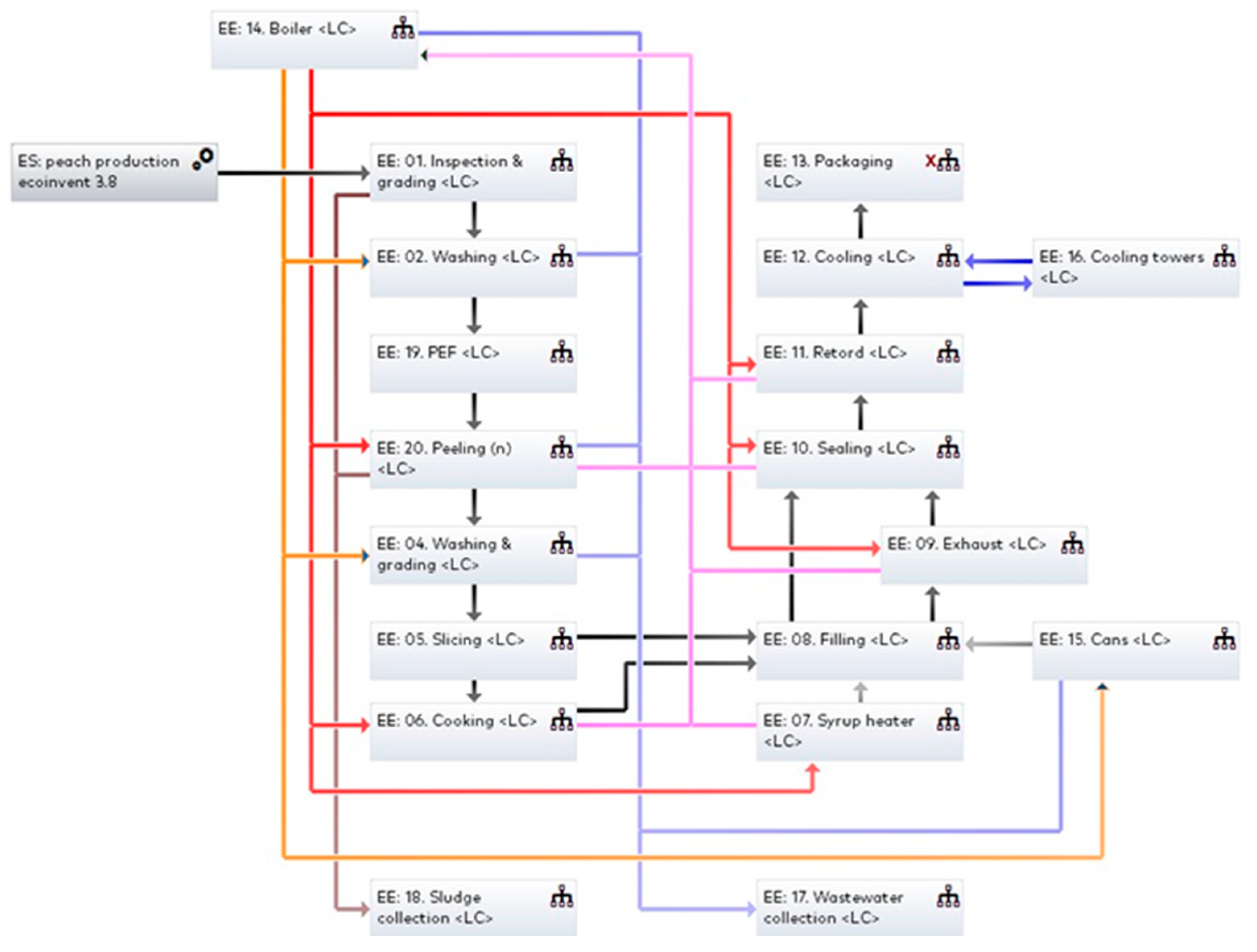


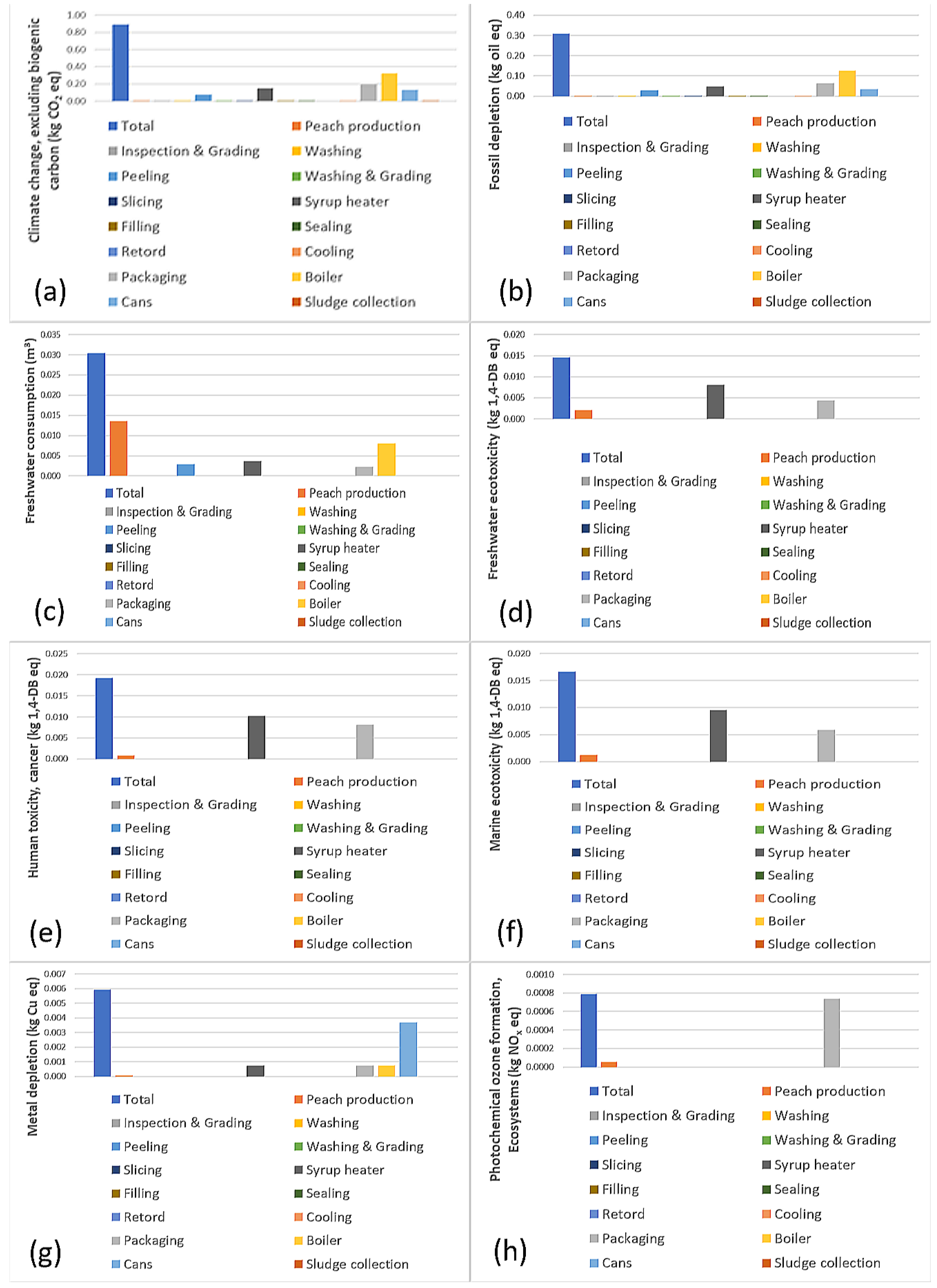
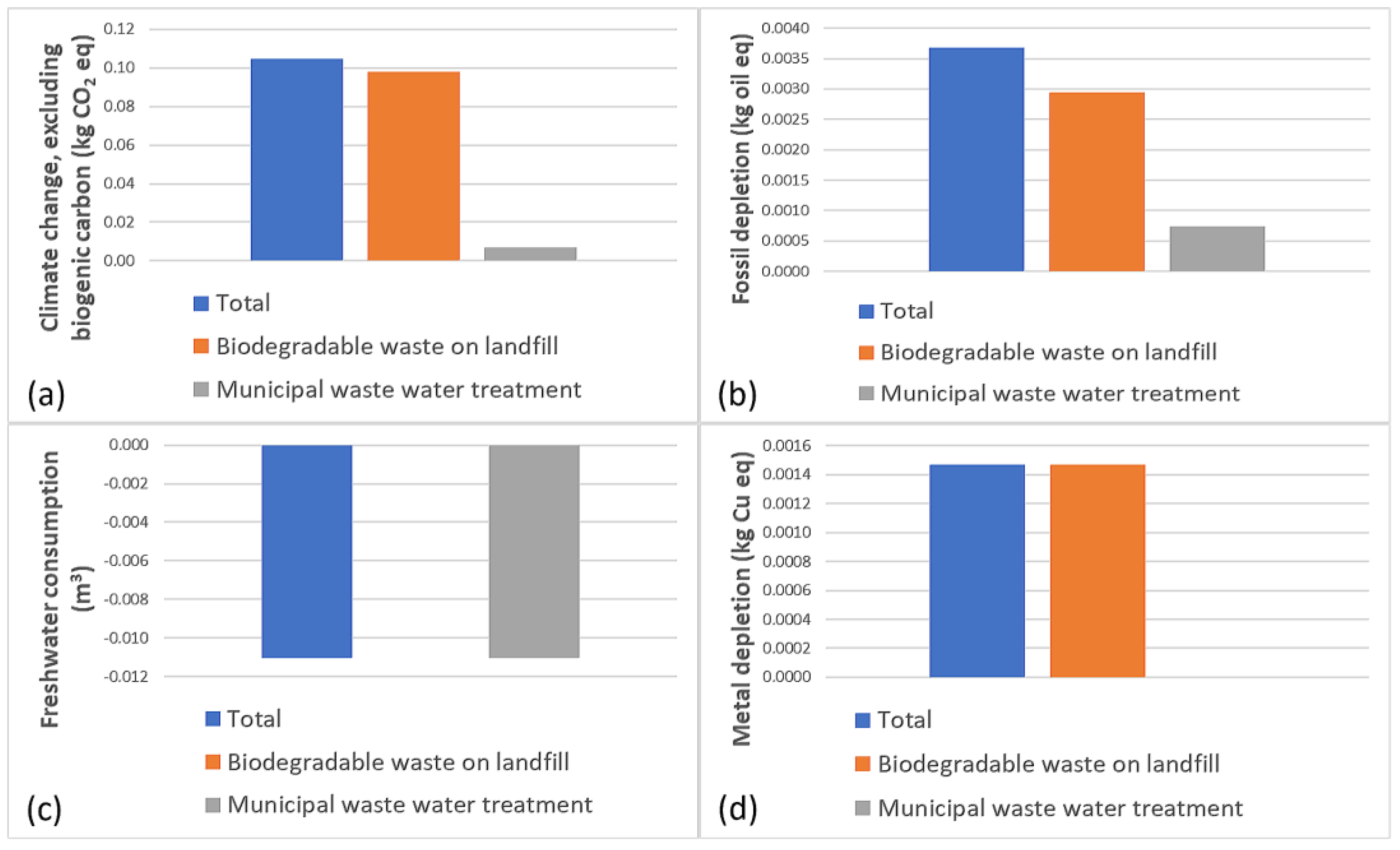
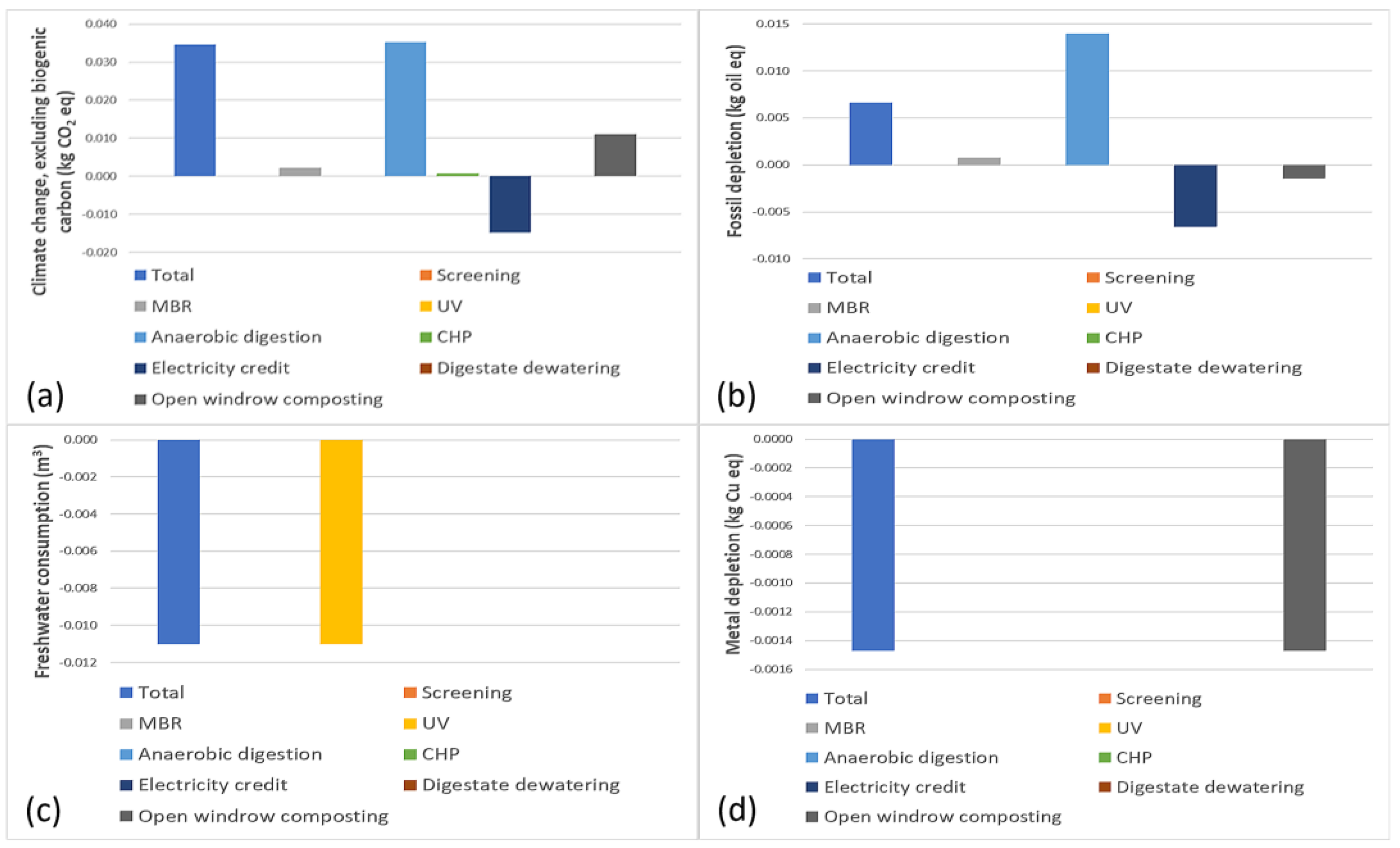
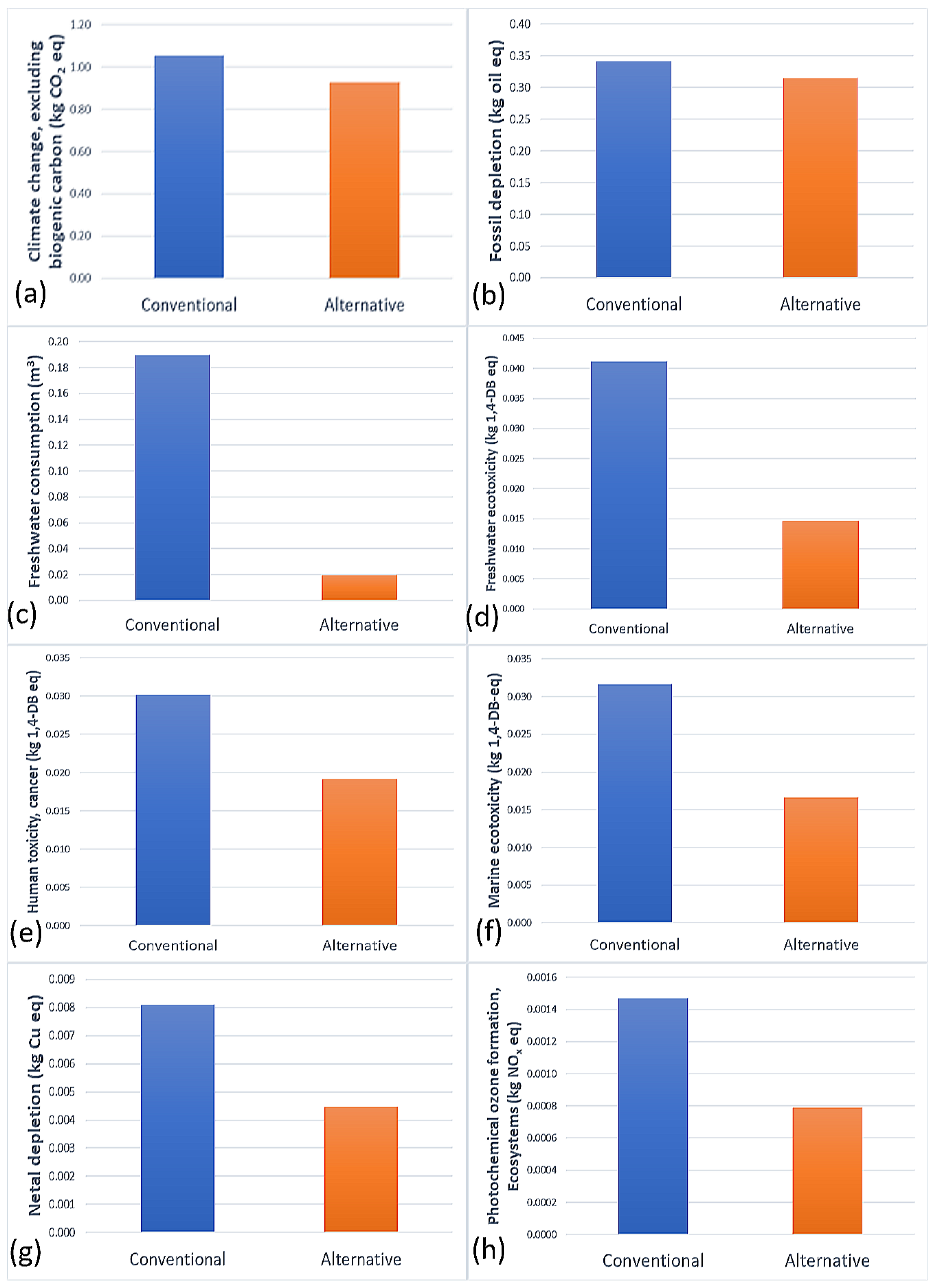
| Process | Input/Output | Flow | Unit | Value |
|---|---|---|---|---|
| Inspection and Grading | In | Fruit | kg | 0.87 |
| In | Electricity | kJ | 15.50 | |
| Out | Solid waste 1 (rejected fruits) | kg | 0.13 | |
| Out | Fruit | kg | 0.74 | |
| Washing | In | Fruit | kg | 0.74 |
| In | Hot water | kg | 3.34 | |
| In | Electricity | kJ | 15.50 | |
| Out | Fruit | kg | 0.74 | |
| Out | Wastewater 1 | kg | 3.34 | |
| Peeling | In | Fruit | kg | 0.74 |
| In | Steam | kg | 0.08 | |
| In | Lye | kg | 3.34 | |
| In | Electricity | kJ | 7.76 | |
| Out | Peeled fruits | kg | 0.73 | |
| Out | Solid waste 2 (peels) | kg | 0.01 | |
| Out | Wastewater 2 | kg | 3.34 | |
| Out | Condensate | kg | 0.08 | |
| Washing and Grading | In | Fruit | kg | 0.73 |
| In | Hot water | kg | 3.34 | |
| In | Electricity | kJ | 15.50 | |
| Out | Fruit | kg | 0.73 | |
| Out | Wastewater 3 | kg | 3.34 | |
| Slicing | In | Fruit | kg | 0.73 |
| In | Electricity | kJ | 27.20 | |
| Out | Fruit | kg | 0.40 | |
| Out | Fruit | kg | 0.33 | |
| Cooking | In | Fruit | kg | 0.40 |
| In | Steam | kg | 0.13 | |
| Out | Fruit | kg | 0.32 | |
| Out | Condensate | kg | 0.13 | |
| Out | Water vapor (to atmosphere) | kg | 0.08 | |
| Syrup Heater | In | Glucose | kg | 0.12 |
| In | Water | kg | 0.24 | |
| In | Steam | kg | 0.10 | |
| Out | Syrup | kg | 0.35 | |
| Out | Condensate | kg | 0.10 | |
| Out | Vapor | kg | 0.02 | |
| Filling | In | Cans | kg | 0.05 |
| In | Syrup | kg | 0.35 | |
| In | Fruit | kg | 0.33 | |
| In | Fruit | kg | 0.32 | |
| In | Electricity | kJ | 23.30 | |
| Out | Cans | kg | 0.50 | |
| Out | Cans | kg | 0.50 | |
| Exhausting | In | Cans | kg | 0.50 |
| In | Steam | kg | 0.07 | |
| Out | Cans | kg | 0.50 | |
| Out | Condensate | kg | 0.07 | |
| Sealing | In | Cans | kg | 0.50 |
| In | Steam | kg | 0.04 | |
| In | Cans | kg | 0.50 | |
| In | Electricity | kJ | 15.50 | |
| Out | Sealed cans | kg | 1.00 | |
| Out | Condensate | kg | 0.02 | |
| Out | Water vapor (to atmosphere) | kg | 0.02 | |
| Retort | In | Sealed cans | kg | 1.00 |
| In | Steam | kg | 0.13 | |
| Out | Sealed cans | kg | 1.00 | |
| Out | Condensate | kg | 0.10 | |
| Out | Water vapor (to atmosphere) | kg | 0.03 | |
| Cooling | In | Sealed cans | kg | 1.00 |
| In | Cold water | kg | 7.34 | |
| Out | Electricity | kJ | 15.50 | |
| Out | Sealed cans | kg | 1.00 | |
| Out | Cold water | kg | 7.34 | |
| Packaging | In | Sealed cans | kg | 1.00 |
| In | Cardboard box | kg | 0.20 | |
| In | Electricity | kJ | 34.90 | |
| Out | Packaged can fruits | kg | 1.00 | |
| Boiler | In | Condensate | kg | 0.50 |
| In | Water (make up) | kg | 7.74 | |
| In | Air | kg | 3.34 | |
| In | Fuel | kJ | 4700.00 | |
| Out | Steam | kg | 0.55 | |
| Out | Hot water | kg | 7.34 | |
| Out | Wastewater 4 | kg | 0.35 | |
| Out | Stack | kg | 3.34 | |
| Can washing | In | Cans | kg | 0.05 |
| In | Hot water | kg | 0.67 | |
| Out | Cans | kg | 0.05 | |
| Out | Wastewater 5 | kg | 0.67 | |
| Cooling towers | In | Cold water | kg | 7.34 |
| In | Electricity | kJ | 0.51 | |
| Out | Cold water | kg | 7.34 | |
| Wastewater collection | In | Wastewater 1 | kg | 3.34 |
| In | Wastewater 2 | kg | 3.34 | |
| In | Wastewater 3 | kg | 3.34 | |
| In | Wastewater 4 | kg | 0.35 | |
| In | Wastewater 5 | kg | 0.67 | |
| Out | Wastewater | kg | 11.00 | |
| Solid wastes collection | In | Solid wastes 1 | kg | 0.13 |
| In | Solid wastes 2 | kg | 0.01 | |
| In | Electricity | kJ | 6.65 | |
| Out | Solid wastes | kg | 0.14 | |
| Total electric energy consumed | kJ | 178.00 | ||
| Process | Input/Output | Flow | Unit | Value |
|---|---|---|---|---|
| Municipal wastewater treatment | In | Wastewater | kg | 11.00 |
| Biodegradable waste in landfill | In | Solid wastes | kg | 0.14 |
| Process | Input/Output | Flow | Unit | Value |
|---|---|---|---|---|
| PEF [23] | In | Fruit | kg | 0.74 |
| In | Electricity | kJ | 0.26 | |
| Out | Fruit | kg | 0.74 | |
| Peeling (new) [23] | In | Fruit | kg | 0.74 |
| In | Steam | kg | 0.08 | |
| In | Lye | kg | 3.34 | |
| In | Electricity | kJ | 5.43 | |
| Out | Peeled fruits | kg | 0.73 | |
| Out | Solid waste (peels) | kg | 0.01 | |
| Out | Wastewater | kg | 3.34 | |
| Out | Condensate | kg | 0.08 | |
| Screening [24] | In | Wastewater | kg | 6.67 |
| In | Electricity | kJ | 0.01 | |
| Out | Wastewater | kg | 6.67 | |
| Out | Solids | kg | 7.35 × 10−4 | |
| Membrane bioreactor [25] | In | Wastewater | kg | 6.67 |
| In | Electricity | kJ | 14.80 | |
| Out | Wastewater | kg | 6.67 | |
| UV treatment [26] | In | Wastewater | kg | 15.80 |
| In | Electricity | kJ | 6.67 | |
| Out | Clean water | kg | 0.01 | |
| Anaerobic digestion [27] | In | Solid wastes | kg | 6.67 |
| In | Solid wastes from screening | kg | 7.35 × 10−4 | |
| In | Electricity | kJ | 1.17 | |
| In | Fuel | kJ | 13.60 | |
| In | Water | kg | 0.03 | |
| Out | Biogas | kJ | 4.20 × 10−3 | |
| Out | Digestate | kg | 0.01 | |
| CHP [27] | In | Biogas | kJ | 4.20 × 10−3 |
| Out | Heat | kJ | 3.62 | |
| Out | Electricity | kJ | 3.22 | |
| Digestate thickening [28] | In | Digestate | kg | 7.50 × 10−4 |
| In | Electricity | kJ | 1.35 × 10−3 | |
| Out | To compost | kg | 7.27 × 10−6 |
| Impact Category | Production without PEF | Production with PEF | % Reduction |
|---|---|---|---|
| Climate change (kg CO2, eq) | 0.9490 | 0.8910 | 6.11 |
| Fossil depletion (kg oil, eq) | 0.3380 | 0.3080 | 8.88 |
| Freshwater consumption (m3) | 0.2010 | 0.0304 | 84.88 |
| Freshwater ecotoxicity (kg 1,4-DB eq) | 0.0412 | 0.0146 | 64.56 |
| Human toxicity—cancer (kg 1,4-DB eq) | 0.0294 | 0.0192 | 34.69 |
| Marine ecotoxicity (kg 1,4-DB eq) | 0.0316 | 0.0166 | 47.46 |
| Metal depletion (kg Cu eq) | 0.0066 | 0.0059 | 10.61 |
| Photochemical ozone formation—ecosystems (kg NOx eq) | 0.0015 | 0.0008 | 46.67 |
| Impact Category | Conventional Treatment | Alternative Treatment | % Reduction |
|---|---|---|---|
| Climate change (kg CO2, eq) | 0.1040 | 0.0346 | 66.73 |
| Fossil depletion (kg oil, eq) | 0.0037 | 0.0066 | −78.38 |
| Freshwater consumption (m3) | −0.0110 | −0.0110 | - |
| Metal depletion (kg Cu eq) | 0.0015 | −0.0015 | 200.00 |
| Impact Category | Conventional Scenario | Alternative Scenario | % Reduction |
|---|---|---|---|
| Climate change (kg CO2, eq) | 1.0500 | 0.9260 | 11.81 |
| Fossil depletion (kg oil, eq) | 0.3410 | 0.3150 | 7.62 |
| Freshwater consumption (m3) | 0.1900 | 0.0194 | 89.79 |
| Freshwater ecotoxicity (kg 1,4-DB eq), | 0.0412 | 0.0146 | 64.56 |
| Human toxicity—cancer (kg 1,4-DB eq) | 0.0301 | 0.0192 | 36.21 |
| Marine ecotoxicity (kg 1,4-DB eq) | 0.0316 | 0.0166 | 47.47 |
| Metal depletion (kg Cu eq) | 0.0081 | 0.0045 | 44.55 |
| Photochemical ozone formation—ecosystems (kg NOx eq) | 0.0015 | 0.0008 | 46.67 |
| Fruit-Vegetable | Climate Change (kg CO2 eq) | Reference |
|---|---|---|
| Canned peaches | 0.926 | Present study |
| Canned sweet corn | 1.200 | [34] |
| Canned diced tomatoes | 1.02 | [35] |
| Canned lychee | 0.813 | [36] |
| Canned pineapple | 1.200 | [37] |
| Tomato ketchup | 1.220 | [35] |
| Impact Category (*10−3) | Low Efficiency (0.061 cm3 CH4/kg VS) | Medium Efficiency (0.139 cm3 CH4/kg VS | High Efficiency (0.217E cm3 CH4/kg VS) |
|---|---|---|---|
| Climate change (kg CO2, eq) | +1.5% | 926.00 | −1.4% |
| Fossil depletion (kg oil, eq) | +1.7% | 315.00 | −1.7% |
| Freshwater consumption (m3) | - | 19.40 | - |
| Freshwater ecotoxicity (kg 1,4-DB eq), | - | 14.60 | - |
| Human toxicity—cancer (kg 1,4-DB eq) | - | 19.20 | - |
| Marine ecotoxicity (kg 1,4-DB eq) | - | 16.60 | - |
| Metal depletion (kg Cu eq) | +0.4% | 4.47 | −0.2% |
| Photochemical ozone formation—ecosystems (kg NOx eq) | +0.6% | 0.79 | −0.6% |
Disclaimer/Publisher’s Note: The statements, opinions and data contained in all publications are solely those of the individual author(s) and contributor(s) and not of MDPI and/or the editor(s). MDPI and/or the editor(s) disclaim responsibility for any injury to people or property resulting from any ideas, methods, instructions or products referred to in the content. |
© 2023 by the authors. Licensee MDPI, Basel, Switzerland. This article is an open access article distributed under the terms and conditions of the Creative Commons Attribution (CC BY) license (https://creativecommons.org/licenses/by/4.0/).
Share and Cite
Drosou, F.; Kekes, T.; Boukouvalas, C. Life Cycle Assessment of the Canned Fruits Industry: Sustainability through Waste Valorization and Implementation of Innovative Techniques. AgriEngineering 2023, 5, 395-412. https://doi.org/10.3390/agriengineering5010026
Drosou F, Kekes T, Boukouvalas C. Life Cycle Assessment of the Canned Fruits Industry: Sustainability through Waste Valorization and Implementation of Innovative Techniques. AgriEngineering. 2023; 5(1):395-412. https://doi.org/10.3390/agriengineering5010026
Chicago/Turabian StyleDrosou, Fotini, Tryfon Kekes, and Christos Boukouvalas. 2023. "Life Cycle Assessment of the Canned Fruits Industry: Sustainability through Waste Valorization and Implementation of Innovative Techniques" AgriEngineering 5, no. 1: 395-412. https://doi.org/10.3390/agriengineering5010026
APA StyleDrosou, F., Kekes, T., & Boukouvalas, C. (2023). Life Cycle Assessment of the Canned Fruits Industry: Sustainability through Waste Valorization and Implementation of Innovative Techniques. AgriEngineering, 5(1), 395-412. https://doi.org/10.3390/agriengineering5010026






